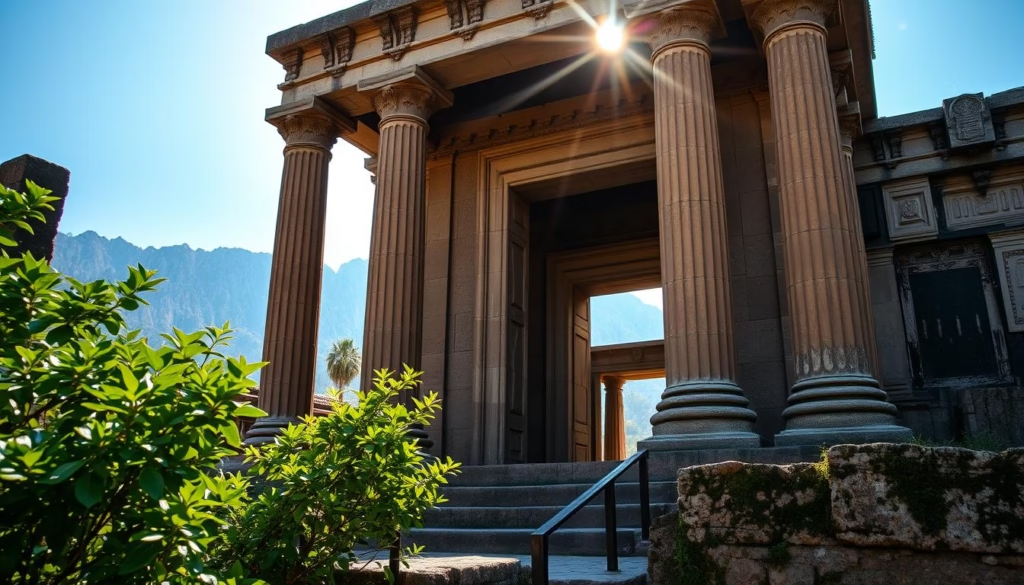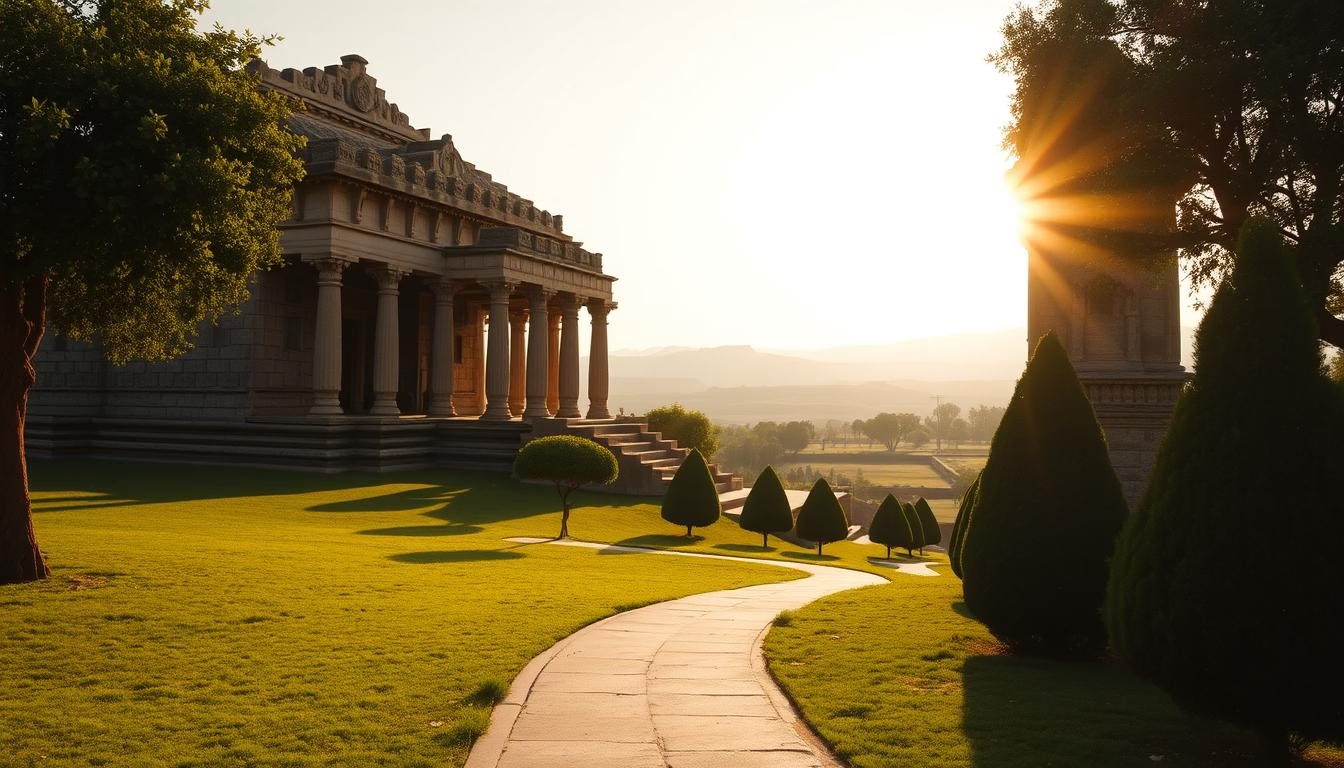Discover the Oldest Temples in the World: Ancient Wonders
Let’s step back in time to explore humanity’s earliest attempts to connect with the divine. Across continents and cultures, sacred structures stand as silent witnesses to civilizations long gone. These marvels of human creativity reveal how our ancestors combined spiritual devotion with groundbreaking engineering.
From towering stone circles to underground sanctuaries, these architectural feats predate writing systems and even agriculture. The Mundeshwari Devi Temple in India, still active after 1,900 years, shows how ancient designs endure. Each structure tells a unique story through its columns, carvings, and ceremonial spaces.
What makes these creations truly remarkable? They demonstrate universal human impulses – to honor forces beyond our control and leave lasting marks on the landscape. Whether carved into cliffs or built with massive limestone blocks, they required astonishing coordination and skill.
Key Takeaways
- Sacred sites across six continents reveal shared human spiritual instincts
- Construction methods evolved from stacked stones to precise geometric designs
- Many structures served multiple purposes as calendars, gathering spaces, and art galleries
- Archaeologists use tools like carbon dating to verify building timelines
- Several UNESCO World Heritage Sites preserve these cultural treasures
- Functional designs influenced later religious architecture globally
As we journey through these time capsules, you’ll discover how Neolithic builders moved 20-ton stones and why some temples align perfectly with stars. Get ready to see history through archways older than empires.
Introduction to Ancient Temples and Their Significance
From the dawn of civilization, sacred structures united people through shared rituals and collective purpose. These spaces weren’t just for spiritual practices—they became hubs for trade, education, and social bonding. Many now hold world heritage status, safeguarding humanity’s earliest achievements.

Understanding Cultural Heritage and Architectural Evolution
Early builders transformed basic stone arrangements into towering structures with precise alignments. The shift from rough monoliths to carved pillars shows how skills evolved over generations. Archaeologists marvel at how these designs predicted seasonal changes without modern tools.
These sites preserved more than faith. They stored agricultural records, hosted festivals, and trained artisans. A Mesopotamian tablet notes, “The temple’s walls hold both prayers and harvest counts”—proof of their dual roles.
Creating such monuments demanded teamwork. Thousands contributed to construction projects, from quarrying stones to carving symbols. This collaboration laid foundations for cities and legal systems, proving innovation thrives when communities unite.
Today, protecting these heritage site locations remains vital. They teach us about resourcefulness, artistry, and shared human values across millennia.
Oldest Temples in the World: A Journey Through Time
Our ancestors’ drive to create enduring spiritual landmarks appears in stunning sites across continents. These structures challenge assumptions about early societies, revealing sophisticated planning long before cities existed.
When Stones Outlasted Civilizations
Göbekli Tepe in southeastern Turkey stands as one oldest known ritual complex. Built 11,600 years ago, its massive T-shaped pillars predate Egypt’s pyramids by six millennia. Archaeologists found animal carvings and circular enclosures suggesting organized gatherings.
Other early sites show similar ingenuity. Malta’s Ġgantija temples used corbelled roofs in 3600 BCE, while Egypt’s Abydos complex later refined column designs. Each era built upon previous techniques, creating legacies that remain awe-inspiring today.
Separating Fact From Folklore
Local legends often claim extreme ages for sacred sites. At India’s Mundeshwari, inscriptions confirm 1,900-year use despite myths suggesting greater antiquity. Scientists use three key methods to verify timelines:
| Dating Method | Use Case | Accuracy Range |
|---|---|---|
| Carbon-14 Analysis | Organic materials in mortar | ± 40 years |
| Stratigraphy | Soil layer comparison | Relative dating |
| Architectural Style | Column designs/motifs | ± 200 years |
Such techniques revealed Stonehenge’s 1,500-year construction span. From Turkey’s buried monuments to Malta’s weathered stones, these sites continue rewriting human history chapters we thought were closed.
Architectural Styles and Engineering Marvels
Ancient builders transformed raw materials into timeless wonders through sheer ingenuity. Their work reveals how early societies combined practical needs with artistic vision, creating spaces that still inspire awe today.
From Megalithic Structures to Intricate Reliefs
At Turkey’s Göbekli Tepe, 18-foot limestone pillars stand as testaments to Neolithic skill. These T-shaped stones feature detailed carvings of wild animals – foxes leap, snakes coil, and cranes take flight in stone. Meanwhile, Mesopotamia’s Ziggurat of Ur shows how massive foundations supported towering stepped pyramids, though only their bases survive.
Builders mastered complex challenges across continents. Malta’s temple-makers stacked stones without mortar, while Greek architects perfected column designs. Some techniques remain mysteries – how did workers move Stonehenge’s 25-ton slabs 150 miles?
Key innovations shaped these marvels:
- Precision stone-cutting for seamless joints
- Astronomical alignments in temple layouts
- Corbelled roofs spanning 20-foot spaces
The diverse architectural styles developed independently yet share striking similarities. From Egypt’s columned halls to Mayan stepped pyramids, these structures prove human creativity flourishes even without modern tools. Their legacy lives on in today’s skyscrapers and sacred spaces.
UNESCO World Heritage and Global Recognition
Cultural treasures gain new life when the world recognizes their value. UNESCO World Heritage status acts like a global seal of approval, protecting humanity’s shared legacy. To earn this honor, sites must pass strict tests proving their historical, artistic, or scientific importance.
Iconic Sites: Stonehenge, Gobekli Tepe, and Beyond
Four legendary locations showcase how UNESCO World designations help preserve history:
- Stonehenge (1986): Protected from urban sprawl near London
- Göbekli Tepe (2018): Shielded its fragile carvings from looters
- Malta’s Ġgantija (1980): Enabled climate-controlled visitor centers
- Delphi’s Temple of Apollo (1987): Funded earthquake-resistant reinforcements
The evaluation process examines three key factors. Experts check if a world heritage site maintains original materials, tells a complete story about its era, and represents human creativity. Only 1,199 locations worldwide meet these standards.
Global cooperation makes preservation possible. When Turkey’s Göbekli Tepe gained UNESCO World status, 21 countries contributed expertise to protect its 11,600-year-old pillars. Such teamwork helps balance tourism access with conservation needs – a challenge facing 38% of listed sites today.
Cultural and Religious Significance in Ancient Societies
Ancient societies wove spiritual practices into every aspect of life, creating bonds between communities and the cosmos. Sacred spaces became stages for ceremonies that celebrated creation cycles and humanity’s place within them.
Rituals, Festivals, and Pilgrimage Traditions
At Malta’s Ġgantija complex, archaeologists discovered stone carvings of a goddess linked to earth and fertility. Offerings of clay figurines and animal bones suggest rituals asking for abundant harvests. “These practices connected farming cycles to divine forces,” notes research from the University of Chicago’s ritual studies symposium.
Festivals united entire regions. Egypt’s Opet celebration saw statues of gods paraded through Thebes for 11 miles. Communities shared feasts while priests performed purification rites – acts reinforcing social order through shared devotion.
Evidence from Tarxien reveals animal sacrifices were central to some ceremonies. Burn marks on altars match descriptions of offerings to ensure fertile lands. Pilgrims traveled weeks to attend these events, carrying tokens from distant homes.
These traditions shaped cultural identities across generations. Through dance, music, and symbolic acts, people expressed hopes for survival and continuity. Even today, echoes of these practices appear in harvest festivals and community gatherings worldwide.
Exploring Notable Temple Complexes Around the Globe
Three river valleys shaped humanity’s spiritual landscape: the Tigris-Euphrates, Nile, and Mediterranean coasts. These regions birthed iconic structures that blended faith with innovation. Each temple complex reveals how geography and belief systems shaped architectural choices.
Insights from Mesopotamia, Greece, and Egypt
In ancient Mesopotamia, the Ziggurat of Ur rose like a stepped mountain toward the heavens. Built around 2100 BCE, this ziggurat honored Nanna, the moon god. King Ur-Nammu’s workers used 720,000 baked bricks to create its massive base.
Greece’s Temple of Apollo at Delphi held the omphalos stone – believed to mark Earth’s center point. Pilgrims traveled here seeking prophecies from Pythia, the oracle. “Know thyself,” warned inscriptions, blending spirituality with philosophy.
Egypt’s Luxor Temple on the Nile’s eastern bank showcased pharaonic power. Connected to Karnak by a mile-long sphinx avenue, its columns bore carvings of military victories. These sites weren’t just sacred – they were political billboards in stone.
Diversity in Temple Construction and Function
Builders adapted designs to local challenges. Mesopotamians used sun-dried bricks for their flat terrains, while Egyptians employed granite for flood resistance. Greeks perfected marble columns to withstand earthquakes.
| Region | Primary Function | Unique Feature |
|---|---|---|
| Mesopotamia | Administrative hub | Staircase to symbolic heavens |
| Egypt | Royal coronations | Obelisk solar calendars |
| Greece | Oracle consultations | Acoustic prophecy chambers |
These complexes served as early universities and economic engines. The Ziggurat of Ur stored grain surpluses, while Delphi’s temple managed international donations. Workers from across ancient Egypt labored on Luxor, creating a melting pot of skills and ideas.
Mundeshwari Temple: A Case Study in Heritage and Restoration
Preserving ancient heritage often feels like solving a millennia-old puzzle. The Mundeshwari Devi Temple in Bihar embodies this challenge, where historical claims and physical evidence spark lively debates among experts.
Historical Timeline and Architectural Evolution
Local tradition dates this sacred site to 108 CE, potentially making it one oldest temples still in use. However, architectural analysis tells a layered story. The current octagonal shrine emerged during 16th-century renovations, while carvings suggest 6th-century origins.
Discovery phases reveal hidden history. British explorers documented the site in 1790, but critical evidence surfaced later. A 1903 inscription and 2003 royal seal from Sri Lanka’s King Dutthagamani created an archaeological tug-of-war about its true age.
Modern Conservation Efforts and Cultural Impact
The Archaeological Survey of India launched major restorations in 2008. Workers removed centuries of candle soot from delicate reliefs, repaired damaged statues, and installed eco-friendly lighting. These efforts balance preservation with active worship needs.
Today, the temple hosts vibrant festivals while serving as an education hub. Its survival story offers lessons for protecting other temples Malta to Mexico – proving ancient spaces can thrive in modern times through careful stewardship.






